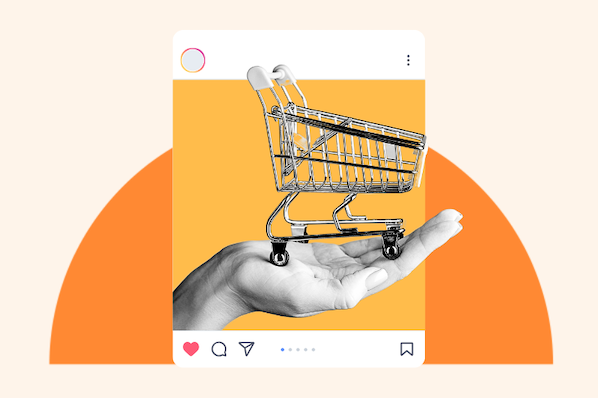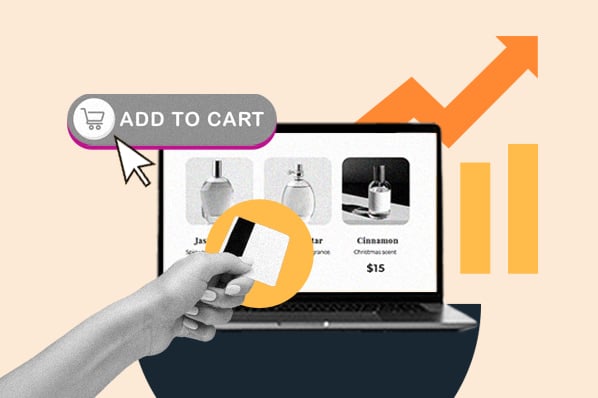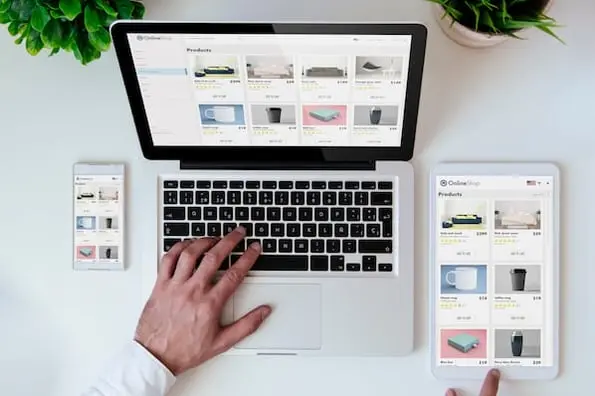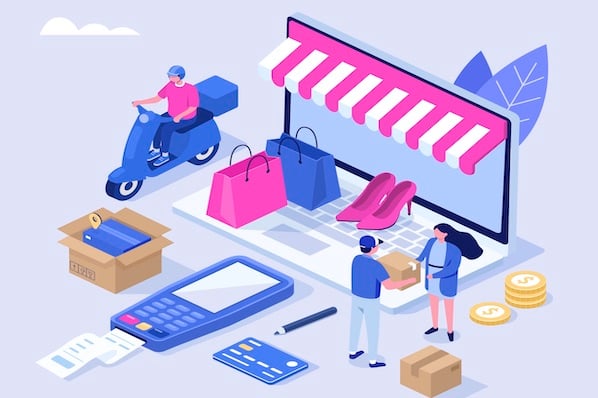Before dropshipping, there were two major ecommerce models:
- Make a unique product from scratch. Do you love knitting cashmere cat sweaters? Great! You’ll have a completely unique product to bring to the marketplace. But can you create demand and scale your business?
- Purchase inventory in bulk. You won’t need to develop a new product, but you might get stuck with a garage full of widgets you can’t sell. If you do get traction, you’ll need to tackle fulfilling and shipping orders on your own.
With dropshipping, you are only responsible for marketing and selling the products. Another person in the supply chain worries about product, inventory, packaging and shipping. But that means rather than finding efficiencies in the system, you’ll need to get very clever to take on Amazon, big box stores and other dropshipping ecommerce stores.
Want more tips on how to be a successful online retailer? Check out this webinar series.
The Pros & Cons of Dropshipping
Dropshipping can sound like a magic bullet for making money online, but don’t be fooled. Like anything else, there are upsides and downsides to dropshipping.
The Pros:
1. No startup capital. If you’re just getting started, dropshipping lets you launch without investing a lot of money. Traditional retailers need to buy and store inventory in order to sell it to consumers. But if you’re using a dropshipper, you can offer a full catalogue of products with little overhead.
2. Less hassle involved. If you manage your own inventory, you need an ecommerce fulfillment system to accurately track the stock and process orders. However, if you choose a dropshipping model, you don’t have to deal with on-hand inventory, which means that you don’t have to handle packing or shipping either. This lets you focus your time and energy on marketing and growing your business
3. You can easily expand your offerings. If you want to expand your offerings, dropshipping is a great way to test new products with your audience. This will allow you to truly see if they’re a market fit without having to invest in large amounts of expensive inventory up-front.
The Cons:
1. Managing the logistics. The logistics for dropshipping can be hard to overcome as your business expands. If your dropshipping supplier relies on multiple warehouses, this will be even more of a challenge. Poor logistics management can lead to a subpar customer experience, due to improper tracking numbers, incorrect addresses and shipping delays.
2. The low barrier to entry. This sounds like a positive, and it is. But at the same time, because of the low barrier to entry, plenty of other people will be selling the same products. This makes it harder to stand out as a new business and means there’s stiff competition. Remember, if a supplier dropshipping for you, they’ll dropship to anyone, and that makes it tough to stand out.
3. No control over the packaging. If you’re an online-only store, the very first physical interaction you have with your customers is when they open their purchase. But if you’re dropshipping, you give up control over the packaging. That means no special touches or cute thank-you cards that can really make your store stand out. These days most reputable dropshippers will at least allow for private label shipping with customized invoicing and packing slips.
4. Tight profit margins. It’s very difficult for small businesses to compete on price, and the nature of dropshipping means you aren’t selling a unique product. Make sure you are ready to invest in something that will differentiate your store, like great educational resources, strong copywriting, or building a unique niche market.
Avoid These Common Dropshipping Mistakes
After you’ve decided to start dropshipping, you need to make sure you’ve got a solid strategy in place from the get-go. And that means avoiding these common mistakes.
Expecting Your Products to Sell Themselves
As mentioned above, dropshipping automatically puts you in a competitive space, because others are selling exactly the same thing that you are. It’s all too easy to think that you’ll be able to set up dropshipping for your store and then have an instant money-maker on your hands.
The opposite is true — when you’re dropshipping, you need to put all of the time that you save on shipping and fulfillment into marketing and SEO. Those are the elements that will drive traffic to your store and make you sales when you’re a dropshipper.
Since you can’t control the fulfillment or packaging with dropshipping, you always want to put a priority focus on quality customer service and giving customers a positive experience with the parts of the buying process that you can control.
Relying Too Much on One Supplier or Not Testing Suppliers
If you rely on one supplier without having a back-up, you’re setting yourself up for logistical issues down the line. What if they raise their prices to a point you can’t afford? Or go out of business? Or simply decide not to work with you any more? Even on the less drastic end of scenarios, they could be out of stock on a product and have no idea when they’ll get it back in stock. Always have a backup supplier that you can turn to if your go-to supplier doesn’t work out for a particular order.
Every time you start working with a new supplier, you should make sure that they cut the mustard by placing test orders. When you get the order, examine it closely, considering the packaging, shipment time and so on, and make sure that everything is top-quality. It’s a good idea to continue placing test orders on a somewhat regular basis. Fulfillment is critically important to any online business, and you want to catch any slips in quality before they become an issue.
Stressing Over Shipping Rates
Dealing with shipping rates can be a hassle, even if you ship all your orders from one location.
If you ship from more than one warehouse, or dropship through multiple suppliers, it can be a nightmare. What if an order draws on two different warehouses, or three different suppliers?
Instead of stressing about multi-location shipping on every single order, take a step back and look at the big picture. What are you trying to achieve? Accurate shipping rates? Or more sales, happy customers, and repeat business? If you’re burning energy over shipping prices on every single order, that’s energy you’re not spending on creating a better shopping experience, growing your store, marketing and so on.
So what should you do instead? Take a look at past orders and use them to work out a flat shipping rate. Or perhaps a tiered rate based on cart value. Will it cut into your profit margins?
Yes, on some orders. But you’ll come out ahead on others, and if you’ve set your flat rate properly, shipping costs will even out over time. There’s also the fact that flat rate and free shipping has been shown to increase conversion rates—one of the main reasons customers abandon their shopping carts is because of shipping costs. A flat shipping fee removes confusion and seemingly “hidden” fees that show up at checkout.
As you can see, dropshipping isn’t a one-size-fits-all solution, but it can be a great way to start or scale an ecommerce store. At every stage of your business, you need to step back and evaluate whether or not dropshipping makes sense for your store.
Dropshipping on Amazon
One place dropshipping has thrived in the past is Amazon. If you want to sell product on the platform, you'll need to be responsible for making sure orders are shipped and stored properly by yourself or the wholesaler you're marketing products for. You also must be transparent about who created the product and who seller is.
According to Amazon, although dropshipping on the site is acceptable, sellers must be as transparent as possible so the customer knows who they are buying a product from and where they can contact if there's an issue. The seller and marketer must also be responsible for processing and managing returns without Amazon's assistance.
For businesses that don't want to pay warehouse costs, Amazon offers an FBA (or Fulfilled By Amazon) service where vendors can ship products through the them. However, the seller of the products is still transparently listed as the dropshipper and products are not affiliated Amazon.
With the FBA program, Amazon receives a client's products in bulk. They will then warehouse the bulk safely in their own locations and use their own service to ship to customers on behalf of the vendor. Amazon has also partnered with Shopify so that its ecommerce clients can also take advantage of the service and avoid warehousing.
According to Oberlo, this service has a number of benefits, like low warehouse costs. However, it's also heavily regulated by Amazon so there's not much wiggle room to adjust Amazon's pre-set dropshipping process.
For example, dropshippers must follow FBA policies including one which states they cannot purchase products from another vendor and re-sell them under their own name.
Dropshipping on eBay
With the auction site. eBay, you can create an account and business listing and then start selling or auctioning off your products.
While it's easy to list and sell your or your wholesalers products on eBay, vendors do have to pay various fees, such as Final Value Fees, which eBay describes as a percentage of the total purchase. This total purchase amount includes shipping but excludes sales tax.
Additionally, while eBay allows dropshipping, its process is also regulated. While you can sell items from a wholesaler, you can't purchase the same items from another eBay seller and then resell them as your own. They still also require similar levels of transparency so the seller of the item and contact information is clear. Like Amazon, the seller must deal with any returns, order management, or any product complaints.
Ecommerce Marketing



![How to Write an Ecommerce Business Plan [Examples & Template]](https://53.fs1.hubspotusercontent-na1.net/hubfs/53/ecommerce%20business%20plan.png)




.jpg)
![How to Start an Ecommerce Business [Steps + Must-Follow Tips]](https://53.fs1.hubspotusercontent-na1.net/hubfs/53/how%20to%20start%20an%20ecommerce%20business.jpg)


